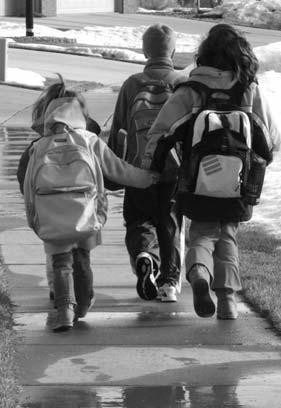
7 minute read
Why All the Talking about Walking?
By Nancy Surprenant, RLA, former SDDOT Bicycle and Pedestrian Coordinator
Some of you who attended this fall’s SD Municipal League Conference may have had the opportunity to attend my presentation on conducting walk audits in your community. I’m not sure whether it was the tantalizing topic or the fact it was the last session before they gave away the big screen television that drew such a large crowd! Regardless, I hope you went home from the conference with some great information, but I also hope you went home thinking about why walk audits and the numerous other conference topics are important. Hopefully, you were asking yourself, your fellow council persons or co-workers a variety of questions, such as how did this conference session apply to our community? Why is this topic important to us? Why should we implement this new idea in our community? Or, how do we get this idea, project or program to be successful in the community in which we live and work? The purpose of this article is to help you answer some of those questions on the walk audit topic and, hopefully, help you move ahead with a few ideas to make your community more walkable. So, let’s get started!
Advertisement
Why all this talk about walking?
Having just completed almost five years with the SD Department of Transportation, I’ve had the opportunity to travel all over throughout our great state and to visit, or at least pass through, many of your communities – big and small. I don’t think I’ve ever driven through Philip, during the day, when I haven’t passed someone walking along Highway 14. I can count on one hand the times I’ve driven from Miller to St. Lawrence and haven’t witnessed a walker or biker on the trail between those two towns. I’ve seen children walking to school, adults walking home from the store with a bag of groceries, folks out walking for exercise, mothers pushing strollers, seniors carefully making their way down town and even folks traveling in their motorized wheelchairs or mobility aid devices down the streets of our small communities. People in South Dakota walk! Some on two legs; some with the aid of two wheels or a cane; some with the aid of four wheels – but no matter the style in which they are doing it, people in South Dakota ‘walk’!
Why is walking important to the residents, potential home buyers and visitors to our community?
The reasons why walking and walkable communities are important are unlimited, but here are a few quick facts that tell the story: j 32% of children and adolescents in SD are overweight or obese. Physical activity can lower the risk of becoming obese and developing related diseases. (www.HealthySD.gov) j The most preferred form of physical activity, for seniors, is walking. It can be done inside or out and only requires a good pair of shoes. (www.HealthySD.gov) j South Dakota leads the nation in the percentage of young children with both parents in the work force.
Seventy-four percent of children younger than six have both parents in the work force. (Rapid City
Journal, 2008). With both parents at work, the result is more children walking to and from school and other activities throughout the year. j According to the National Association of Realtors, 77 percent of respondents to their Community Preference
Survey said they would ‘look for neighborhoods with abundant sidewalks’. If you are trying to attract homebuyers to your community, walkability is important. j US Census Bureau data shows that over 15% of South
Dakota’s population is over 65 years in age.
According to a 2012 AARP South Dakota Survey of
Sioux Falls residents over age 50, a total of 75% of survey respondents said it was either extremely important or very important for them to remain in their community as long as possible. You likely have elderly residents in your community that are living on their own and may not be able to drive, but still can and still like to walk.
What are the three most important City or County ordinances for walkers? 1.An ordinance that requires sidewalk in new
developments. Yes, this means in both residential and commercial neighborhoods. And yes, this means even if there is no existing sidewalk on the next property.
You have to start somewhere. If you never require the first piece of sidewalk to be built, you will never have sidewalk in your community. Although you can’t change the mistakes of your predecessors, you can change how your community moves forward. You can fill in the gaps later, but start requiring sidewalk now.
2.An ordinance that requires property owners to
maintain their sidewalk. Many South Dakota communities have this ordinance already in place, but have not been diligent in enforcing it. Therefore, sidewalks have fallen into disrepair or have been removed and never replaced. Tackle this on a block by
block basis. It may take a number of years to work your way through the community doing inspections and repairs but, again, you need to start somewhere.
Prioritize routes by those that connect to schools, downtown, medical services and other day-to-day use areas. There are a variety of ways to fund this type of project, such as a frontage foot fee, a split between homeowner and City, or other options. Talk to some communities that have tackled these repairs and find a funding option that works best for you.
3.An ordinance that requires snow removal on
sidewalks. Again, there are a variety of ways to address snow removal. Most communities require something like the removal of over two inches of snow within 48 hours of the snow fall. Sadly, some communities have removed these ordinances from the books so that elderly residences don’t have to remove snow. Again, before you go this route, try to find an alternative –perhaps a civic group, friends, neighbors or even a paid company (funded by donations) to assist homeowners who cannot complete the removals themselves.
Contact your local planning district or other communities for examples of these ordinances for your community.
What else can we do to make walking easier in our community?
In large or small communities, one of the biggest steps you can take towards a walkable community is just good, solid community planning. As you are planning a new development or even just the construction of one new building, think about the location, the potential users and the best route to walk to the new development or structure. In short, complete a walk audit before you do the final site selection. If it is a school location, carefully consider what route children and staff will take to the new school. Will they have to cross a railroad track, go past the grain elevator or busy industry, or cross a major street or highway? If it is a senior housing or assisted living facility, is it close to downtown, medical services, the post office or other daily needs? If it is a housing development with young families as the potential homeowners, where will the sidewalk or pathway connections be located? It is a lot easier to deal with these questions before ground breaking than afterwards. If no alternate site is available, then consider the costs of the sidewalk or connectors in your project costs, bonding or other funding requests.

How do we balance the costs of sidewalks with the many other needs of our community?
Often times, sidewalk improvements can get lost in the day to day needs of a community. It is easy to say street projects, sewer and water projects or a new fire station takes precedence over sidewalk. But, many times the sidewalk project can be tied in with these other projects, significantly reducing the cost. If you are already rebuilding a street and putting in curb and gutter and storm sewer, the additional cost and quantity of concrete for sidewalks becomes much more economical. The quantity of the concrete and the grading and utility work that is already part of the street project helps to minimize the cost of the sidewalk – and you are only messing up your residents’ front yards once! Also, consider funding sources that are only applicable to sidewalk or walking related projects. The SD Department of Transportation administers Federal funds through the Transportation Alternatives Program. The SD Department of Health has a variety of funding sources they administer, but also has great connections to other funding options. Although none of this money is free, it can come with a minimal match to help you accomplish your goals.
You can do it!
Turning your community into a walkable community may take some time. But remember, this is a project for your community from which everyone can gain. Whether you walk for exercise, for transportation or just from the parking spot to the store front to shop – everyone is a pedestrian at some part of the day. Opening up ‘walkable’ opportunities in your community helps your children, your residents without a driver’s license, your elderly, your citizens with mobility challenges and you. So, let’s get walking!










